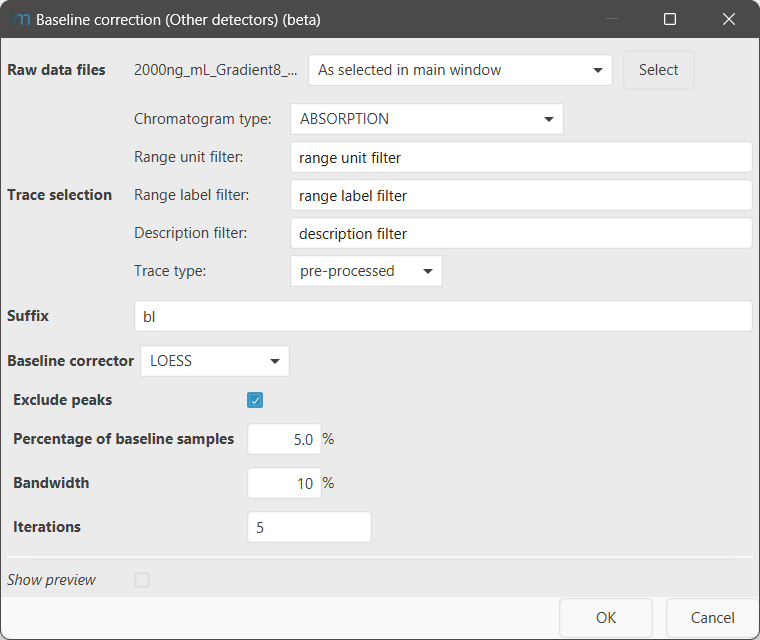Baseline correction (Other detectors)¶
Info
To process data from other detectors, the Other detector service of mzmine is required. This feature is included in the mzmine PRO subscription. Academic program and other users can reach out to inquire access options.
Baseline correction is a useful tool to correct for large drifts in baseline during chromatographic separation. However, it can be tricky to optimize the baseline correction.
Info
While baseline correction can correct some drifts in the baseline, the better approach is usually to acquire a reference wavelength and reference the acquired data on that during the data acquisition.
Parameters¶

Raw data files¶
Select the MS data files to baseline correct the selected traces of.
Trace selection¶
Select the specific traces you want to baseline correct. Typically, it is not necessary to baseline correct all existing traces, but only the ones you want to correlate with the MS, e.g., the UV ( =Absorption) traces
For a detailed description of all sub-parameters see trace selection parameter.
Suffix¶
A suffix that will be appended to the name of the individual trace.
Baseline correctors¶
Exclude peaks (all correctors)¶
If selected, two iterations per baseline correction will be performed internally. Initially the baseline is corrected for the full chromatogram. Then, the baseline is subtracted and a peak detection is performed to exclude peaks from the baseline calculation. In a second iteration, the baseline correction is reapplied to the chromatogram, without including the peaks in the baseline calculation.
Percentage of samples¶
Specify how many of the data points of the chromatogram shall be included in the baseline calculation. This values depends on the acquisition rate of the detector and if previous binning has been applied. The higher the acquisition rate, the lower the percentage of samples.
Loess¶
The LOESS (locally estimated scatterplot smoothing) baseline corrector fits the data using the LOESS algorithm. It is the recommended baseline corrector in most scenarios, due to it's robustness. The LOESS baseline corrector smoothes the baseline data.
Bandwidth¶
Specify how wide the window for the baseline calculation should be at any point of the chromatogram. E.g., 10% means that 10% of the total data points are used at any specific retention time. For a chromatographic run of 10 min, a total window of 1 min around each point will be taken into account.
Iterations¶
Specify how many iteratiosn the LOESS algorithm shall perform. This is independent of the iterations specified in the exclude peaks parameter. This parameter may increase robustness against sudden changes in the baseline.
Polynomial¶
The polynomial baseline corrector fits the data using an nth degree polynomial.
Degree of Polynomial¶
Specify the degree of the polynomial. The higher the degree, the more the baseline will resemble the original data (which may be a disadvantage).
Spline¶
The Spline baseline corrector uses a 3rd degree polynomial to fit 3 points of the raw data. This means, that every input point will appear 1:1 in the corrected data, without any smoothing or fitting (see LOESS, Polynomial).
Optimization¶
The show preview option is recommended to optimize the baseline correction.
Percentage of samples¶
The percentage of samples specifies how many data points of the baseline will be included in the baseline correction. This parameter depends vastly on the acquisition rate. The influence of this parameter is shown here:

Iterations (LOESS)¶
Increasing the number of iterations may reduce the occurrence of ghost peaks due to baseline correction. In case this does not help, trimming traces may be the better option.
